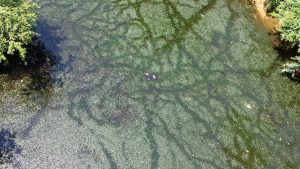Monoecious Hydrilla Biology and Management
Monoecious hydrilla is one of the two hydrilla biotypes found in the U.S. First confirmed in North Carolina in 1980, it has spread across the state and infests many water bodies. We conduct research to improve knowledge of hydrilla biology, increase survey efficiency in detecting hydrilla, and improve hydrilla management programs. Our extension efforts assist managers with detecting, quantifying, and managing this invasive plant.

Publications:
- Monoecious hydrilla – a review of the literature.
- Monoecious hydrilla tuber dynamics following various management regimes on four North Carolina reservoirs.
Hydrilla Management Programs:
Theses/Dissertations:
- Haug, Erika. 2018. Monoecious Hydrilla and Crested Floating Heart Biology, and the Response of Aquatic Plant Species to Florpyrauxifen-benzyl Herbicide.
- Henry, Amy. 2017. Monoecious Hydrilla (Hydrilla verticillata (L.f) Royle) Growth and Phenology in Two Dissimilar Climates.
- Howell, Andrew. 2017. Detecting, Mapping, and Quantifying Macrophytes Using Novel Boat-based Remote Sensing Technologies.
- Regan, Shannon. 2017. Factors Affecting Monoecious Hydrilla (Hydrilla verticillata) in Dynamic Systems.
- Nawrocki, Justin. 2016. Factors Influencing Native Aquatic Plant Revegetation Success for Enhanced Sport Fish Habitat in North Carolina Piedmont Reservoirs.
- Hartis, Brett. 2013. Mapping, Monitoring and Modeling Submersed Aquatic Vegetation Species and Communities.
- Meadows, Sarah. 2013. Monoecious Hydrilla Biology and Response to Select Herbicides.
- Nawrocki, Justin. 2011. Environmental and Physiological Factors Affecting Submersed Aquatic Management.

